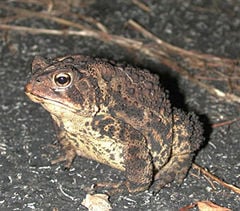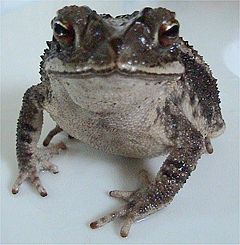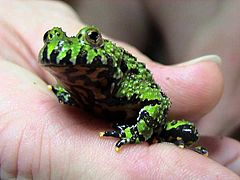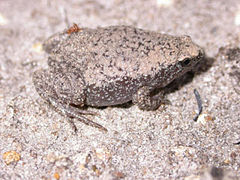Difference between revisions of "Toad" - New World Encyclopedia
({{Contracted}}) |
Katya Swarts (talk | contribs) |
||
| Line 1: | Line 1: | ||
{{Claimed}}{{Contracted}} | {{Claimed}}{{Contracted}} | ||
| + | |||
| + | {{Taxobox | ||
| + | | color = pink | ||
| + | | name = Toads | ||
| + | | image = Bufo periglenes1.jpg | ||
| + | | image_width = 240px | ||
| + | | image_caption = [[Golden Toad]], ''Bufo periglenes'' | ||
| + | | regnum = [[Animal]]ia | ||
| + | | phylum = [[Chordate|Chordata]] | ||
| + | | classis = [[Amphibia]] | ||
| + | | ordo = [[Anura]] | ||
| + | | subdivision_ranks = Families | ||
| + | | subdivision = At least 9, see article. | ||
| + | }} | ||
| + | |||
| + | '''Toad''' refers to a number of [[species]] of [[amphibian]]s. A distinction is often made between [[frog]]s and toads by their appearance, prompted by the [[convergent evolution|convergent adaptation]] among so-called toads to dry environments, which often entails a brown skin for camouflage which is also dry and leathery for better water retention. Many so-called toads also [[burrow]], which requires further adaptations. However, these adaptations merely reflect the environment a species has adapted to, and are not reliable indicators of its ancestry. Since [[taxonomy]] reflects only evolutionary relationships, any distinction between frogs and toads is irrelevant to their classification. | ||
| + | |||
| + | For instance, many members of the families [[Bombinatoridae]], [[Discoglossidae]], [[Pelobatidae]], [[Rhinophrynidae]], [[Scaphiopodidae]], and some species from the [[Microhylidae]] family are commonly called "toads". However, the only family exclusively given the common name "toad" is '''''Bufonidae''''', the "[[true toad]]s". Some "[[true frog]]s" of the genus ''[[Rana (genus)|Rana]]'', have also adapted to burrowing habits, while the species within the toad genus ''[[Atelopus]]'' are conversely known by the common name "[[harlequin frog]]s". | ||
| + | |||
| + | The [[type species]] of the family Bufonidae is the [[Common Toad]], ''Bufo bufo'', and around it cluster a large number of species of the same genus and some smaller genera. ''B. bufo'' is a [[tail]]less amphibian of stout build with a [[tubercle|warty]] skin and any animal that shares these characteristics is liable to be called a toad, regardless of its location in formal taxonomy. | ||
| + | |||
| + | Almost all toads of the family Bufonidae have two lumps on either side of the back of their head, called the [[parotoid gland]]s. These glands contain a poison, which oozes out if the toad is stressed. Some, like the [[Cane Toad]] ''Bufo marinus'', are more toxic than others. Some "[[psychoactive toad]]s" such as the [[Colorado River Toad]] ''Bufo alvaris'', have been used [[recreational drug|recreationally]] for the effects of the [[bufotoxin]], by either their skin secretions or eating boiled toads. | ||
| + | |||
| + | == Taxonomy == | ||
| + | {| align=right | ||
| + | |[[Image:Bufo americanus1.jpg|thumb|240px|American Toad, ''[[Bufo americanus]]'']] | ||
| + | |- | ||
| + | |[[Image:Bufo valliceps.jpg|thumb|240px|Gulf Coast Toad, ''[[Bufo valliceps]]'']] | ||
| + | |- | ||
| + | |||
| + | |[[Image:Bombina orientalis.jpg|thumb|240px|Oriental Fire-bellied Toad, ''[[Bombina orientalis]]'']] | ||
| + | |- | ||
| + | |[[Image:Gastrophryne carolinensis.jpg|thumb|240px|Eastern Narrowmouthed Toad, ''[[Gastrophryne carolinensis]]'']] | ||
| + | |} | ||
| + | === True toads === | ||
| + | '''Family [[Bufonidae]]''' ([[John Edward Gray|Gray]], 1825) - True Toads: | ||
| + | *''[[Adenomus]]'' ([[Edward Drinker Cope|Cope]], 1861) | ||
| + | *''[[Altiphrynoides]]'' (Dubois, 1987) | ||
| + | *''[[Andinophryne]]'' (Hoogmoed, 1985) | ||
| + | *''[[Ansonia (genus)|Ansonia]]'' (Stoliczka, 1870) | ||
| + | *''[[Atelophryniscus]]'' (McCranie, Wilson & Williams, 1989) | ||
| + | *''[[Atelopus]]'' ([[André Marie Constant Duméril|Duméril]] & [[Gabriel Bibron|Bibron]], 1841) | ||
| + | *''[[Bufo]]'' ([[Josephus Nicolaus Laurenti|Laurenti]], 1768) | ||
| + | *''[[Bufoides]]'' (Pillai & Yazdani, 1973) | ||
| + | *''[[Capensibufo]]'' (Grandison, 1980) | ||
| + | *''[[Churamiti]]'' (Channing & Stanley, 2002) | ||
| + | *''[[Crepidophryne]]'' ([[Edward Drinker Cope|Cope]], 1889) | ||
| + | *''[[Dendrophryniscus]]'' (Jiménez de la Espada, 1871) | ||
| + | *''[[Didynamipus]]'' (Andersson, 1903) | ||
| + | *''[[Frostius]]'' (Cannatella, 1986) | ||
| + | *''[[Laurenhryne]]'' (Tihen, 1960) | ||
| + | *''[[Leptophryne]]'' ([[Leopold Fitzinger|Fitzinger]], 1843) | ||
| + | *''[[Melanophryniscus]]'' (Gallardo, 1961) | ||
| + | *''[[Mertensophryne]]'' (Tihen, 1960) | ||
| + | *''[[Metaphryniscus]]'' (Señaris, Ayarzagüena & Gorzula, 1994) | ||
| + | *''[[Nectophryne]]'' (Buchholz & [[Wilhelm Peters|Peters]], 1875) | ||
| + | *''[[Nectophrynoides]]'' ([[Gladwyn Kingsley Noble|Noble]], 1926) | ||
| + | *''[[Nimbaphrynoides]]'' (Dubois, 1987) | ||
| + | *''[[Oreophrynella]]'' ([[George Albert Boulenger|Boulenger]], 1895) | ||
| + | *''[[Osornophryne]]'' (Ruiz-Carranza & Hernández-Camacho, 1976) | ||
| + | *''[[Parapelophryne]]'' (Fei, Ye & Jiang, 2003) | ||
| + | *''[[Pedostibes]]'' ([[Albert C. L. G. Günther|Günther]], 1876) | ||
| + | *''[[Pelophryne]]'' ([[Thomas Barbour|Barbour]], 1938) | ||
| + | *''[[Pseudobufo]]'' ([[Johann Jakob von Tschudi|Tschudi]], 1838) | ||
| + | *''[[Rhamphophryne]]'' (Trueb, 1971) | ||
| + | *''[[Schismaderma]]'' (Smith, 1849) | ||
| + | *''[[Spinophrynoides]]'' (Dubois, 1987) | ||
| + | *''[[Stephopaedes]]'' (Channing, 1979) | ||
| + | *''[[Truebella]]'' (Graybeal & Cannatella, 1995) | ||
| + | *''[[Werneria]]'' (Poche, 1903) | ||
| + | *''[[Wolterstorffina]]'' ([[Robert Mertens|Mertens]], 1939) | ||
| + | |||
| + | === Other toad families === | ||
| + | '''Family [[Bombinatoridae]]''' ([[John Edward Gray|Gray]], 1825) - Fire-bellied Toads: | ||
| + | *''[[Barbourula]]'' (Taylor & Noble, 1924) | ||
| + | *''[[Bombina]]'' ([[Lorenz Oken|Oken]], 1816) | ||
| + | |||
| + | '''Family [[Brachyctpoephalidae]]''' ([[Albert C. L. G. Günther|Günther]], 1858) - Shield Toads: | ||
| + | *''[[Brachycephalus]]'' ([[Leopold Fitzinger|Fitzinger]], 1826) | ||
| + | |||
| + | '''Family [[Discoglossidae]]''' ([[Albert C. L. G. Günther|Günther]], 1858) | ||
| + | *''[[Alytes]]'' ([[Johann Georg Wagler|Wagler]], 1830) - Midwife Toad | ||
| + | |||
| + | '''Family [[Microhylidae]]''' ([[Albert C. L. G. Günther|Günther]], 1858) | ||
| + | *Subfamily [[Microhylinae]] - Narrowmouthed Toads: | ||
| + | **''[[Gastrophryne]]'' ([[Leopold Fitzinger|Fitzinger]], 1843) | ||
| + | |||
| + | '''Family [[Pelobatidae]]''' ([[Charles Lucien Jules Laurent Bonaparte|Bonaparte]], 1850) - European Spadefoot Toads: | ||
| + | *''[[Pelobates]]'' ([[Johann Georg Wagler|Wagler]], 1830) | ||
| + | |||
| + | '''Family [[Scaphiopodidae]]''' ([[Edward Drinker Cope|Cope]], 1865) - North American Spadefoot Toads: | ||
| + | *''[[Scaphiopus]]'' ([[John Edwards Holbrook|Holbrook]], 1836) | ||
| + | *''[[Spea]]'' ([[Edward Drinker Cope|Cope]], 1866) | ||
| + | |||
| + | '''Family [[Rhinophrynidae]]''' ([[Albert C. L. G. Günther|Günther]], 1859) - Burrowing Toads: | ||
| + | *''[[Rhinophrynus]]'' ([[André Marie Constant Duméril|Duméril]] and [[Gabriel Bibron|Bibron]], 1841) | ||
| + | |||
| + | == References == | ||
| + | |||
| + | *{{ITIS|ID=173423|taxon=Anura|year=2006|date=4 May}} | ||
| + | |||
| + | == See also == | ||
| + | [[List of frogs and toads by state (U.S.)]] | ||
| + | |||
| + | ==External links== | ||
| + | |||
| + | *[http://www.msnbc.msn.com/id/19028712?GT1=10056 Toad with fluorescent purple markings discovered] | ||
| + | |||
| + | [[Category:Life sciences]] | ||
| + | {{credit|150667918}} | ||
Revision as of 20:39, 12 August 2007
| Toads | ||||||||
|---|---|---|---|---|---|---|---|---|
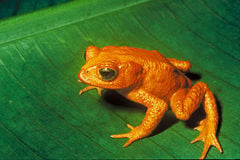 Golden Toad, Bufo periglenes
| ||||||||
| Scientific classification | ||||||||
| ||||||||
|
At least 9, see article. |
Toad refers to a number of species of amphibians. A distinction is often made between frogs and toads by their appearance, prompted by the convergent adaptation among so-called toads to dry environments, which often entails a brown skin for camouflage which is also dry and leathery for better water retention. Many so-called toads also burrow, which requires further adaptations. However, these adaptations merely reflect the environment a species has adapted to, and are not reliable indicators of its ancestry. Since taxonomy reflects only evolutionary relationships, any distinction between frogs and toads is irrelevant to their classification.
For instance, many members of the families Bombinatoridae, Discoglossidae, Pelobatidae, Rhinophrynidae, Scaphiopodidae, and some species from the Microhylidae family are commonly called "toads". However, the only family exclusively given the common name "toad" is Bufonidae, the "true toads". Some "true frogs" of the genus Rana, have also adapted to burrowing habits, while the species within the toad genus Atelopus are conversely known by the common name "harlequin frogs".
The type species of the family Bufonidae is the Common Toad, Bufo bufo, and around it cluster a large number of species of the same genus and some smaller genera. B. bufo is a tailless amphibian of stout build with a warty skin and any animal that shares these characteristics is liable to be called a toad, regardless of its location in formal taxonomy.
Almost all toads of the family Bufonidae have two lumps on either side of the back of their head, called the parotoid glands. These glands contain a poison, which oozes out if the toad is stressed. Some, like the Cane Toad Bufo marinus, are more toxic than others. Some "psychoactive toads" such as the Colorado River Toad Bufo alvaris, have been used recreationally for the effects of the bufotoxin, by either their skin secretions or eating boiled toads.
Taxonomy
True toads
Family Bufonidae (Gray, 1825) - True Toads:
- Adenomus (Cope, 1861)
- Altiphrynoides (Dubois, 1987)
- Andinophryne (Hoogmoed, 1985)
- Ansonia (Stoliczka, 1870)
- Atelophryniscus (McCranie, Wilson & Williams, 1989)
- Atelopus (Duméril & Bibron, 1841)
- Bufo (Laurenti, 1768)
- Bufoides (Pillai & Yazdani, 1973)
- Capensibufo (Grandison, 1980)
- Churamiti (Channing & Stanley, 2002)
- Crepidophryne (Cope, 1889)
- Dendrophryniscus (Jiménez de la Espada, 1871)
- Didynamipus (Andersson, 1903)
- Frostius (Cannatella, 1986)
- Laurenhryne (Tihen, 1960)
- Leptophryne (Fitzinger, 1843)
- Melanophryniscus (Gallardo, 1961)
- Mertensophryne (Tihen, 1960)
- Metaphryniscus (Señaris, Ayarzagüena & Gorzula, 1994)
- Nectophryne (Buchholz & Peters, 1875)
- Nectophrynoides (Noble, 1926)
- Nimbaphrynoides (Dubois, 1987)
- Oreophrynella (Boulenger, 1895)
- Osornophryne (Ruiz-Carranza & Hernández-Camacho, 1976)
- Parapelophryne (Fei, Ye & Jiang, 2003)
- Pedostibes (Günther, 1876)
- Pelophryne (Barbour, 1938)
- Pseudobufo (Tschudi, 1838)
- Rhamphophryne (Trueb, 1971)
- Schismaderma (Smith, 1849)
- Spinophrynoides (Dubois, 1987)
- Stephopaedes (Channing, 1979)
- Truebella (Graybeal & Cannatella, 1995)
- Werneria (Poche, 1903)
- Wolterstorffina (Mertens, 1939)
Other toad families
Family Bombinatoridae (Gray, 1825) - Fire-bellied Toads:
- Barbourula (Taylor & Noble, 1924)
- Bombina (Oken, 1816)
Family Brachyctpoephalidae (Günther, 1858) - Shield Toads:
- Brachycephalus (Fitzinger, 1826)
Family Discoglossidae (Günther, 1858)
- Alytes (Wagler, 1830) - Midwife Toad
Family Microhylidae (Günther, 1858)
- Subfamily Microhylinae - Narrowmouthed Toads:
- Gastrophryne (Fitzinger, 1843)
Family Pelobatidae (Bonaparte, 1850) - European Spadefoot Toads:
- Pelobates (Wagler, 1830)
Family Scaphiopodidae (Cope, 1865) - North American Spadefoot Toads:
- Scaphiopus (Holbrook, 1836)
- Spea (Cope, 1866)
Family Rhinophrynidae (Günther, 1859) - Burrowing Toads:
- Rhinophrynus (Duméril and Bibron, 1841)
ReferencesISBN links support NWE through referral fees
- Anura (TSN 173423). Integrated Taxonomic Information System. Accessed on 4 May 2006.
See also
List of frogs and toads by state (U.S.)
External links
Credits
New World Encyclopedia writers and editors rewrote and completed the Wikipedia article in accordance with New World Encyclopedia standards. This article abides by terms of the Creative Commons CC-by-sa 3.0 License (CC-by-sa), which may be used and disseminated with proper attribution. Credit is due under the terms of this license that can reference both the New World Encyclopedia contributors and the selfless volunteer contributors of the Wikimedia Foundation. To cite this article click here for a list of acceptable citing formats.The history of earlier contributions by wikipedians is accessible to researchers here:
The history of this article since it was imported to New World Encyclopedia:
Note: Some restrictions may apply to use of individual images which are separately licensed.
